2013 Exhibition
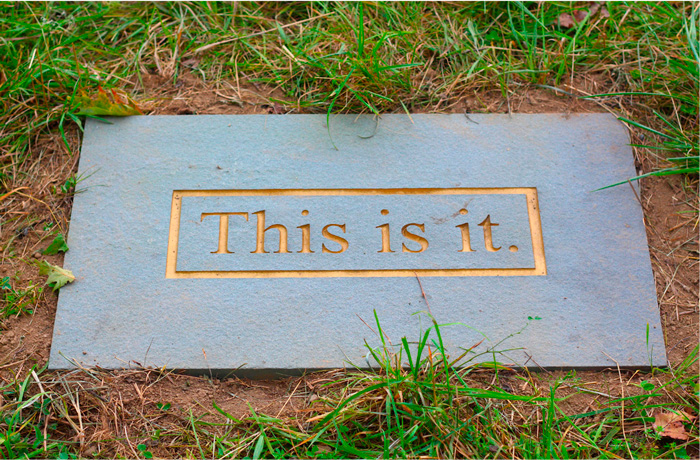
Introduction to the Universe (Copy)
John Allen
stone
John Allen is still a little-known, essentially not-for-profit artist, who lives in the Hudson Valley and does something else for a living. He strives to live without illusions, but willfully indulges in a variety of hopes without remorse. He is a longtime beneficiary of the unannounced and has a collection (by internal possession) of passing sounds.
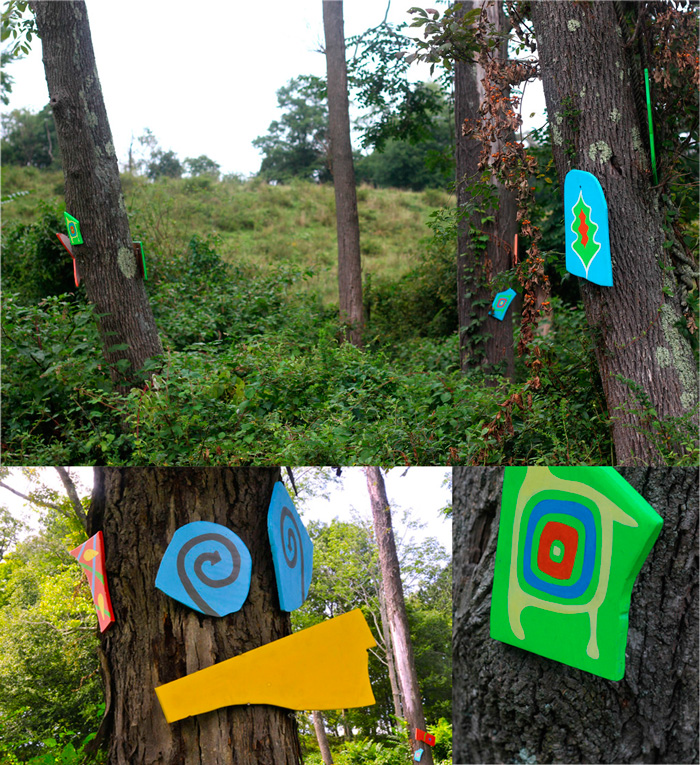
Treesprites (Copy)
Inez Andrucyk
acrylic on wood
In recognition of all things past and the memory of the forest and all its creatures, I have created images to commemorate the history of life within the tree population. This is to say that my own personal living memories are intimately tied in with nature and thus the creation of the work.
As a fantasy creature, the tree sprite hides in the garden and trees, much like an invisible presence of the energy from things past. My work is an attempt to make the invisible come to life as the forms emerge from up above the trees.
There are sixteen sprite pieces tied (no nails) securely around sixteen trees.
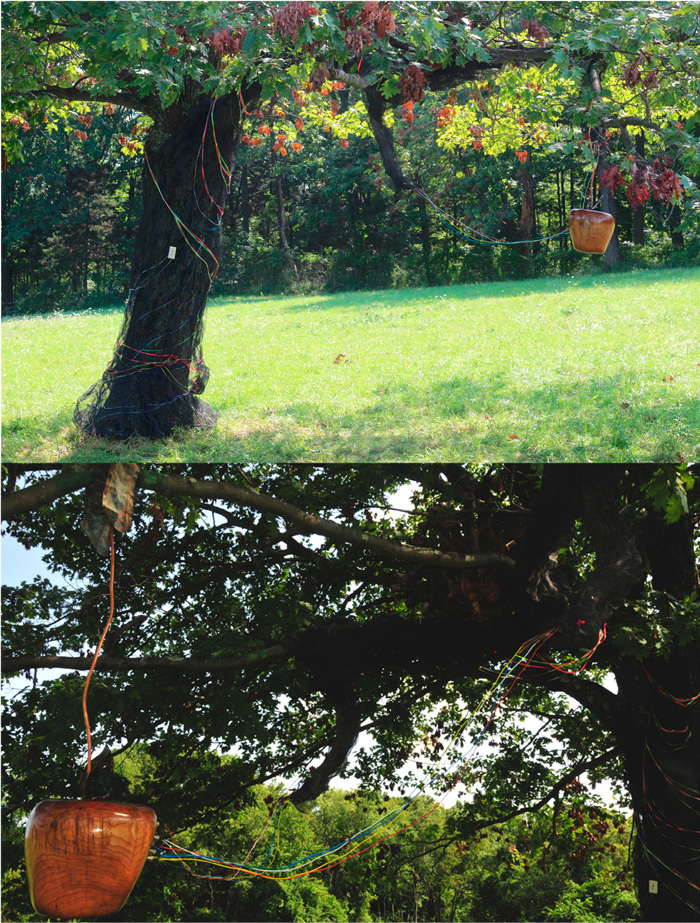
Tree of Knowledge (Copy)
Scott Baer / Augie Della Vecchia
communicaton hardware, copper ribbon
Enjoy a Byte
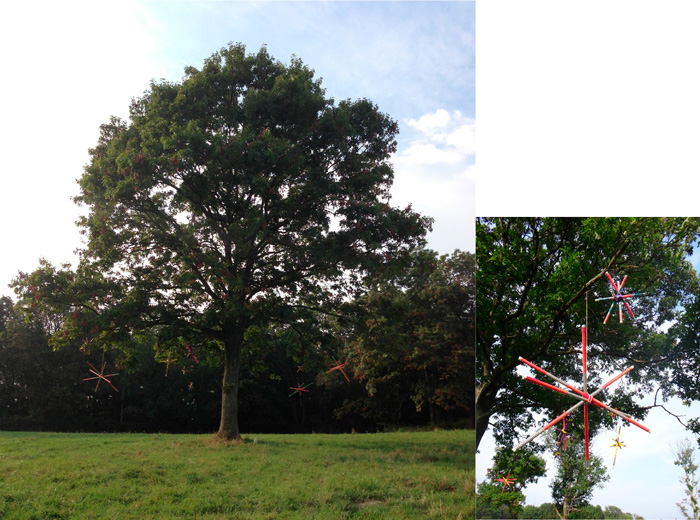
Tree Toys (Copy)
Elizabeth Barksdale
PVC & colored duct tape
In this work from my “Sculpture Toy” series, colorful rods protrude in all directions from where they are bound together into bundles. They appear to explode outward like frozen firecrackers. I suspended my formations at varying heights from branches on all sides of one large tree. They appear to be dancing all around the tree. I playfully call this hanging piece “Tree Toys” as if the tree was playing with them like so many YoYos.
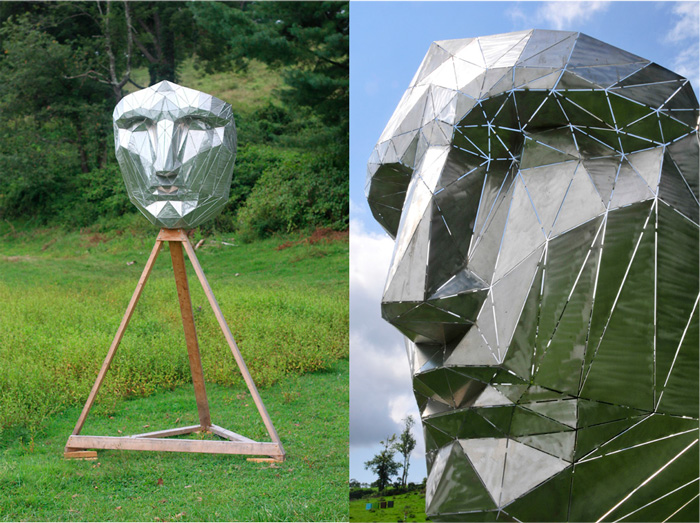
Liberty’s Face (Copy)
John Belardo
aluminum and wood
Leonardo da Vinci’s “Vitruvian Man” has a direct correlation to my work. Da Vinci was the most famous of many artists to interpret the words of Vitruvius Pollio, who said, in reference to classical human proportions, that the figure could be inscribed in a circle and a square. Buckminster Fuller developed the geodesic sphere by subdividing the planar faces of a platonic solid and projecting the convergent points along a radius to closely estimate a true sphere. The geodesic can be interpreted as a modern combination of the circle and the square and is the contemporary framework that I chose to engage Vitruvius. I am exploring how the figure can retain integrity and vitality within a heavy and onerous conceptual and fomal structure. I have always been interested in the way theory affects perception and how abstraction emerges from objectivity; this idea is rooted in science and inspired by nature, in which tension and conflict are creative. In my work a unique form emerges within the composite of two objective forms. In this case I am engaging with the Classical Platonic portrait from the iconic “Statue of Liberty” by Bartholdi.

America Rising (Copy)
Ben Birillo
stainless steel

Lea Bolotin (Copy)
Lea Bolotin
bicycle wheels, water bottles, fishing line, vines, branches
“Treecycle” is a collaboration of recycled materials with branches and twigs found at the farm. I love finding ways to “upcycle” things from everyday
life that are no longer in use. The bottles represent the fruit growing in the tree. The liquid in the bottles is water and food coloring, safe for the
environment. Perhaps if we, as a society, are not resourceful with our man-made materials, this may be the next crop of trees to grow?!
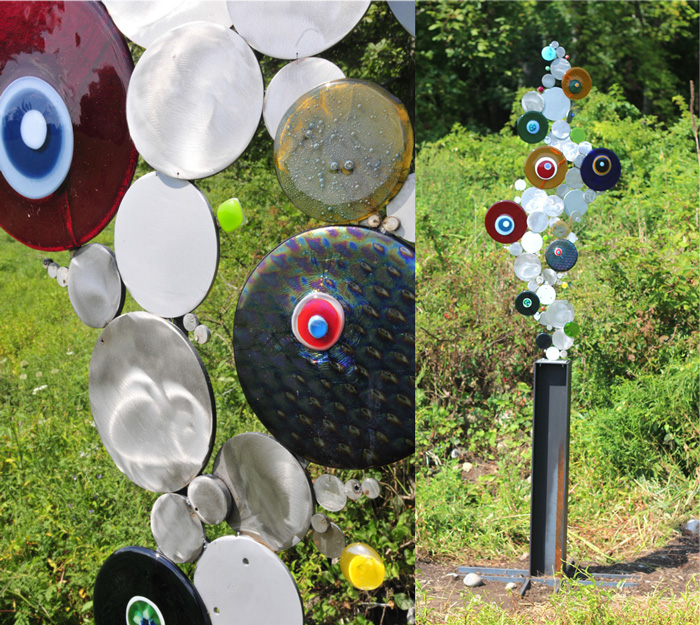
Celestia (Copy)
Cindy Booth / Barbara Galazzo
steel and fused glass
Barbara Galazzo, director of Cold Spring’s Gallery 66 NY and the artistic force behind Galazzo Glass, and mixed-media painter and sculptor Cindy Booth, have collaborated for the first time, to create an installation that they describe as a “dance between metal and glass.” They have christened their glass and metal sculpture “Celestia.” The piece, which stands a sinuous eight and a half feet tall, combines an upward-climbing column of variously-sized welded steel discs, wedded to a profusion of multi-colored and -shaped pieces of art glass.
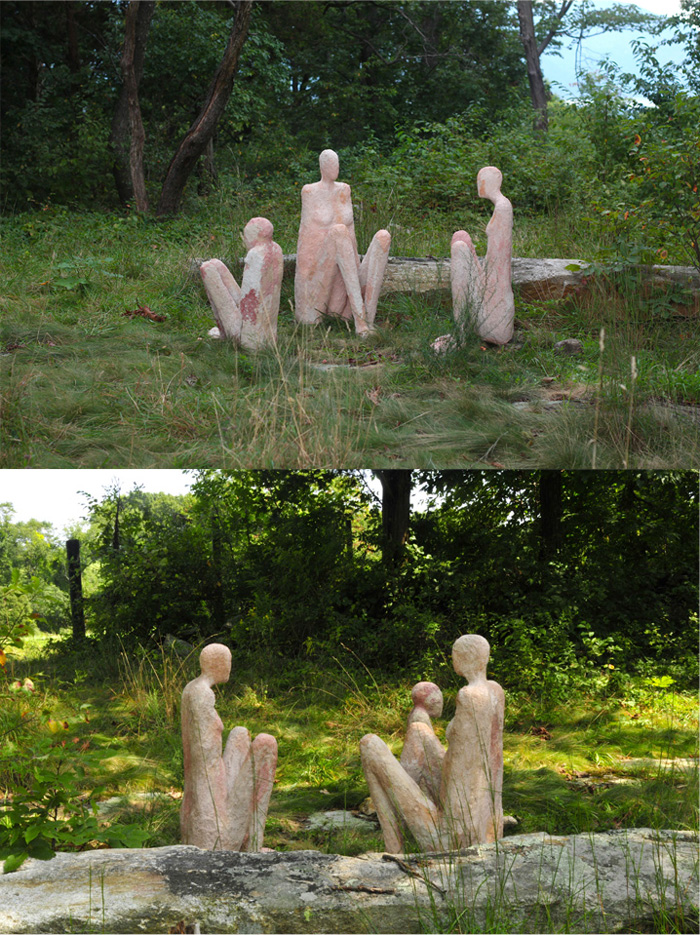
Huddled Figures (Copy)
Jo-Ann Brody
Fossilcrete, steel, foam
The Huddled Figures from last year have become a more autobiographic statement and are once again women.
They are abstracted, rough, and simplified. The mood is pensive; the conversation between figures continues. Are they sitting around a campfire, in their backyard; is it a family; what are they saying?
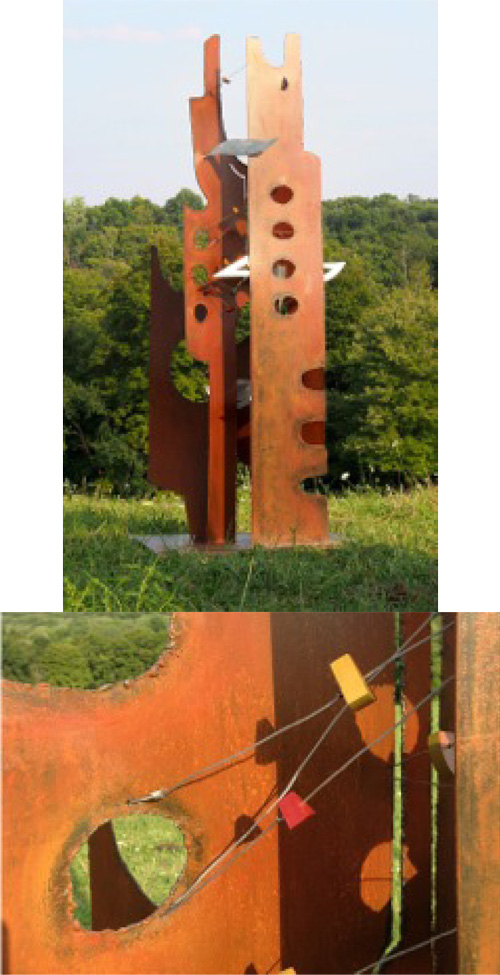
Corn Fields (Copy)
Susan Buroker
steel, stainless steel, sapele mahogany
The sculpture has two parts illustrating the force between nature and science. The cables are woven through the structure representing genetic modification of the corn seed. The wood pieces symbolize the original seed thus creating the web of life.
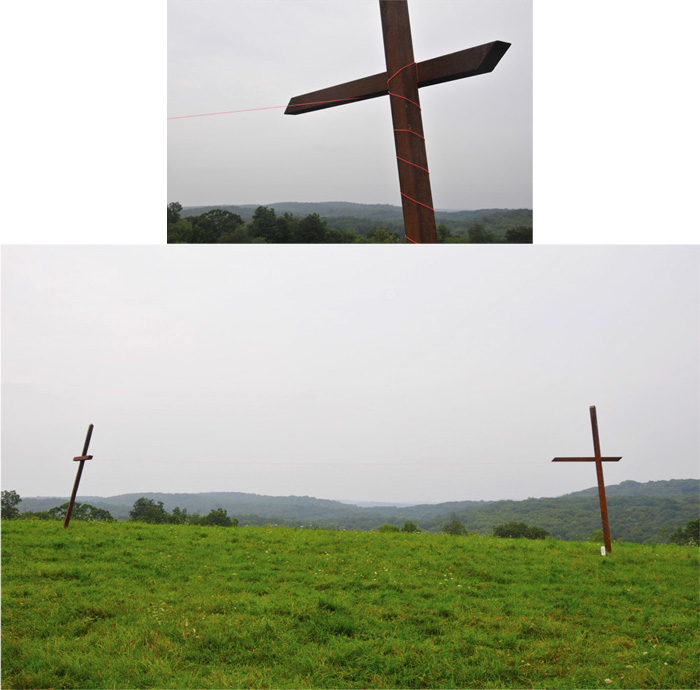
attachment 2 Attachment (Copy)
Diana Carull
rust-patinated box steel, plastic cord attachment
The work “attachment 2 Attachment” allows for disparate elements to be joined in one work.
The woven “attachment” connects to Attachment and connects its two steel structures, literally.
There is still the intention to attract more, which is how Attachment works on its own.
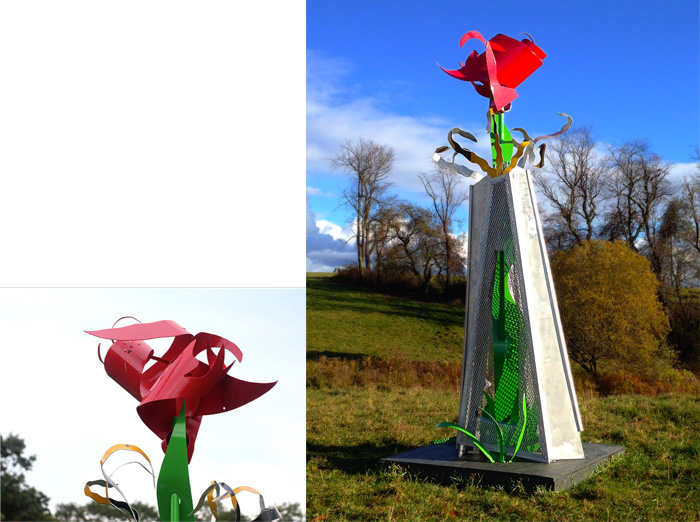
Waking Up (Copy)
Jodi Carlson
aluminum
“Waking Up” (2013) features colorful, curving, organic forms which burst out of a more mechanistic vessel. Within the past few years, I’ve found myself cycling back and forth in my work between organic and mechanistic forms. For some reason the organic feels to me like an intuitive choice, while the mechanistic feels like a “should” (i.e., I want to do the organic but I feel that I should do the mechanistic). With “Waking Up,” I decided to express these two seemingly (for me) disparate impulses visually.
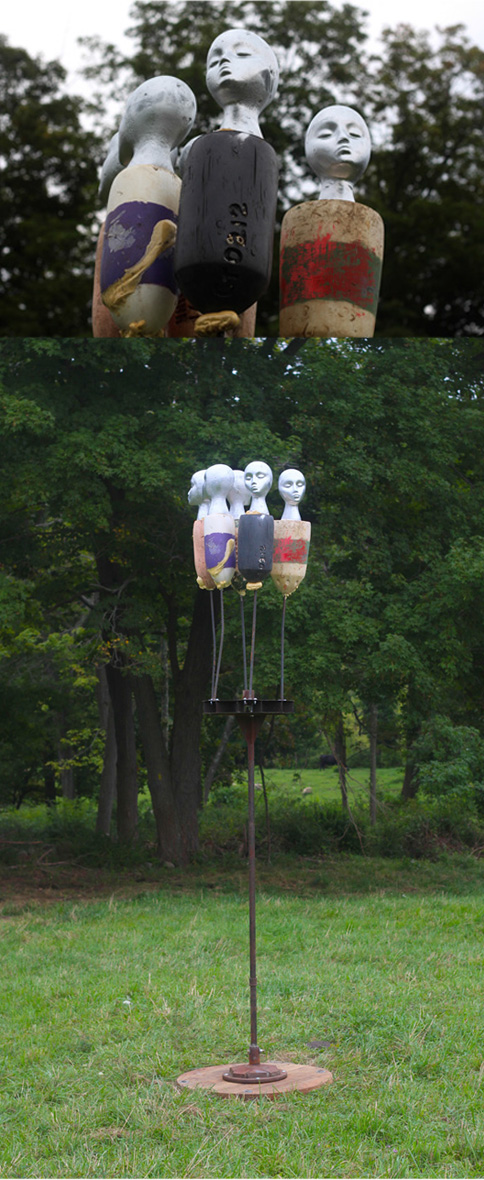
Hydra (Copy)
Steven Ceraso
buoys, mannequin heads, welded steel, wood
This work is part of a series of sculptures that deal with myth and narrative that I have been building over the past few years. The Hydra is a multi-headed mythical creature that symbolizes man’s encounter with difficulties in life and obstacles to overcome. As one problem is solved another is replaced. I have been using the crab or lobster buoys in my work recently and by combining them with the mannequin heads I have added more depth to my visual language. The buoys speak about the environment and the waters that surround us. The “hydra” heads project upward and are
surrounded by a steel circle connected to a wood circular base. These physical circles reference the bonds or circles that groups create.
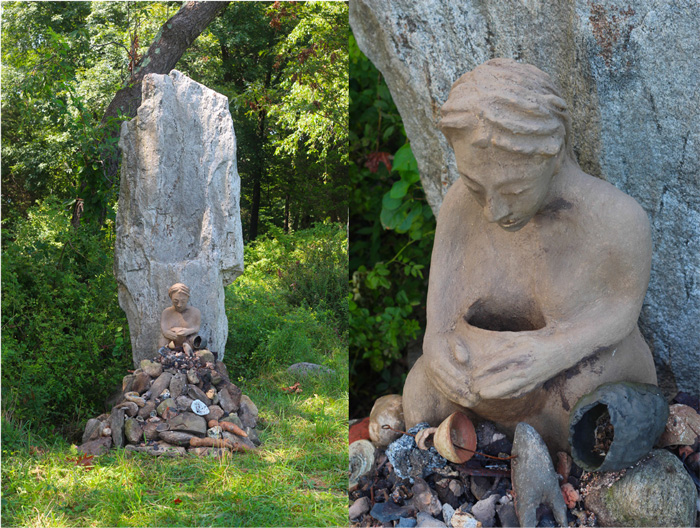
Ada Pilar Working Woman - installationCruz (Copy)
Ada Pilar Cruz
clay figure with monolith, rocks, and clay shards future.
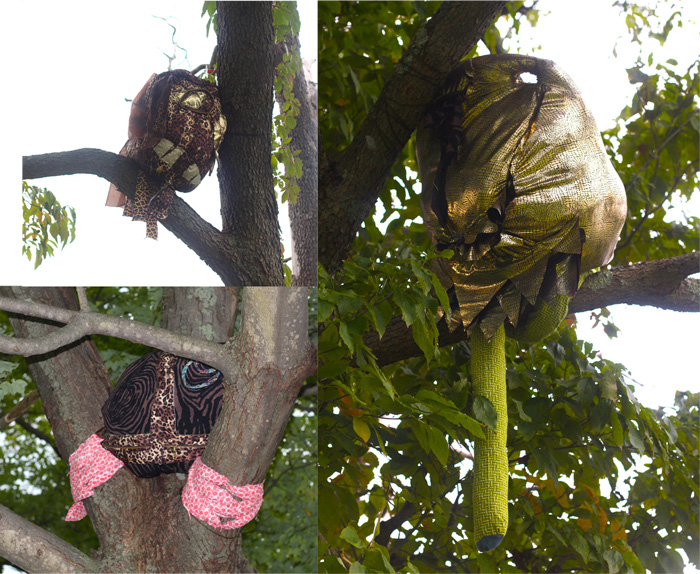
What we do in secret (Copy)
Katrina Ellis
repurposed fabric construction, dimensions variable
“What We Do in Secret” is part of an ongoing series which explores themes of alienation from nature and the natural world. Using re-purposed fabrics, I have combined objects and materials with their own personal histories to create something new, settled in locations that a passer-by might not immediately notice. A project shaped by the human propensity to look for or recognize faces in inanimate objects, these characters are concrete yet have some otherworldly quality, not unlike shadows that animate at night.
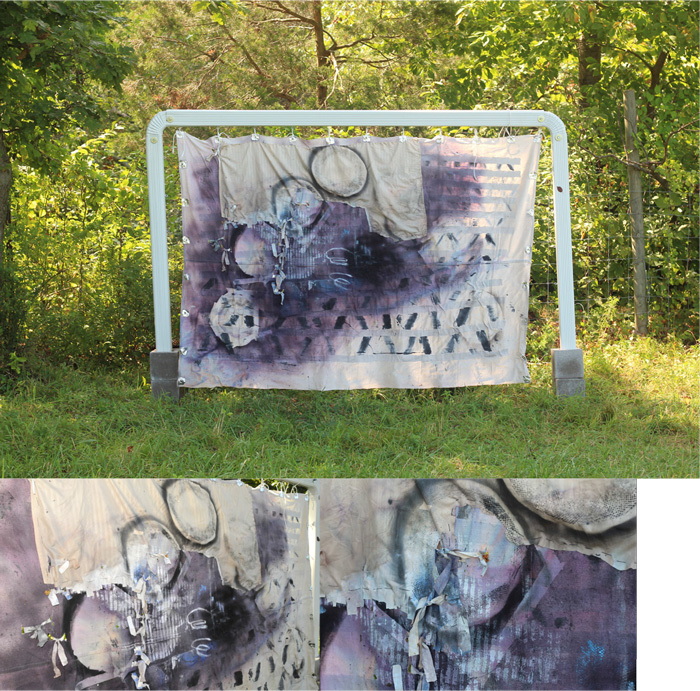
Moon Sauce (Copy)
Florencia Escudero
dye, spray paint, tape on canvas tarp
A self-standing painting on a tarp. I got this idea from spray painting objects in my studio. I realized that I could use this straw hat
as a tool for mark making on a painting. I wanted to use the hat as a stand-in for the moon moving through the sky.
I liked the idea of the moon as a marker of time and that the painting would change as the seasons changed.
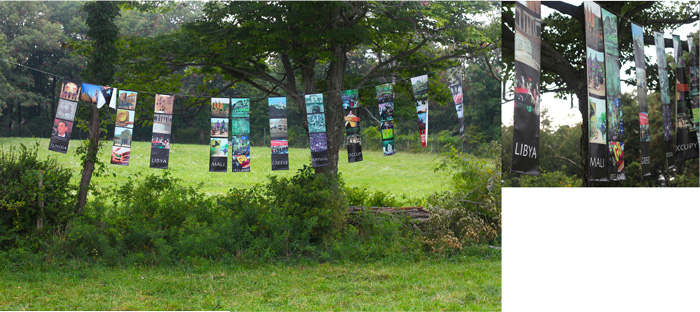
Interesting Times (Copy)
Janet Goldner
vinyl banners, steel cable
“Interesting Times” is a series of 12 banners that present images of cultural sites in countries where there have been recent upheavals along with images of protests.
The individual banners are 1’ x 4 and are strung together and suspended like prayer flags or laundry.
The countries included are Tunisia, Egypt, Libya, Mali, Syria, Greece, Portugal, Ireland, Turkey, Brazil, as well as Occupy Wisconsin, USA. The cultural context is usually missing from reports in the media.
My intension is to show their rich cultural heritage that is important to all of us and the depth of the global crisis.
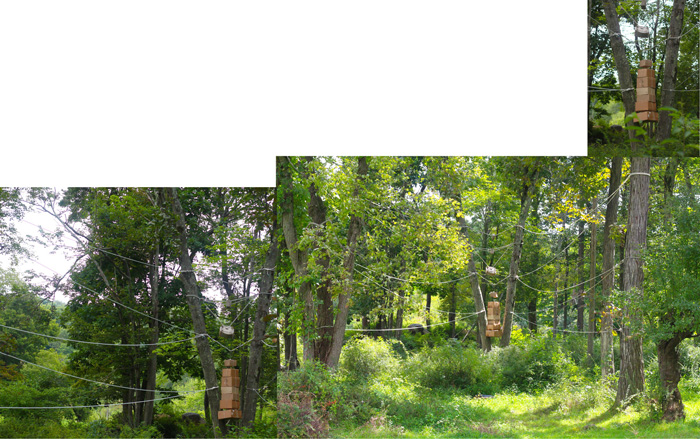
Continuous Draw #7 (Copy)
Ruth Hardinger
rope, concrete, cardboard, trees
sequester carbon. anchor ropes. bark continuous. views.
zenith. box and box. rite. balance. multiple. tall trunks.
fork. branch. contain. change.
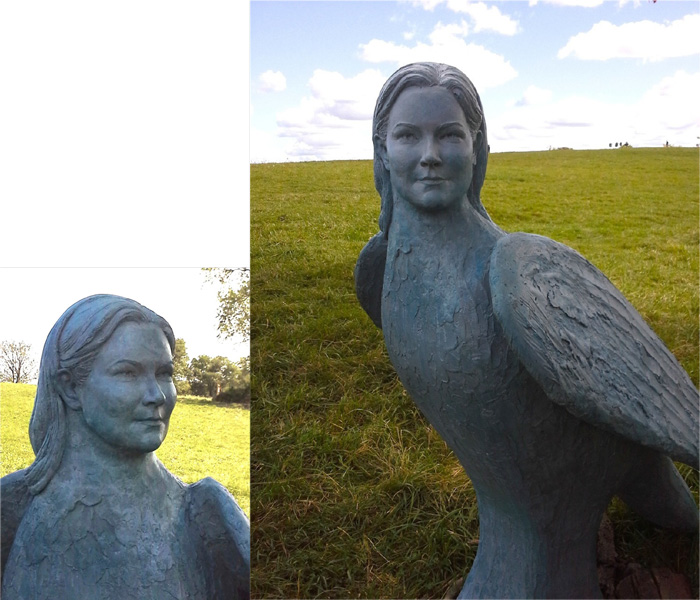
Columbina (Copy)
Sarah Haviland
reinforced cement
“Columbina” joins my series of human-headed bird-figures, made in reinforced cement. The expression and pose of the lifelike female portrait with soft blue bird’s body, set under the gnarled oak in the fields atop Saunders Farm, suggest a classical mythic persona and a poignant mystery.
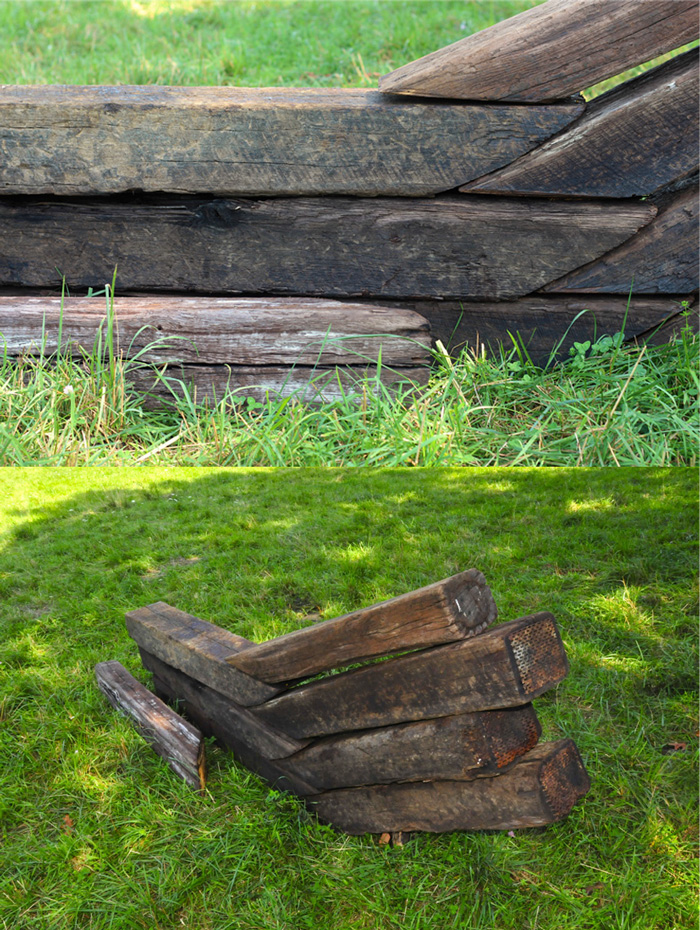
Cut Ties (Copy)
George Heintz
wood, metal
We all know the devastating impact that Sandy has left on the Tri-state areas shoreline. The storm has covered our beaches with
debris and garbage for miles. Many are still trying to recover and rebuild, and that is exactly what I have been doing over the past year is rebuild. I have looked the coast up and down daily searching for pieces of storm-ravaged wood documenting my journey along the way.
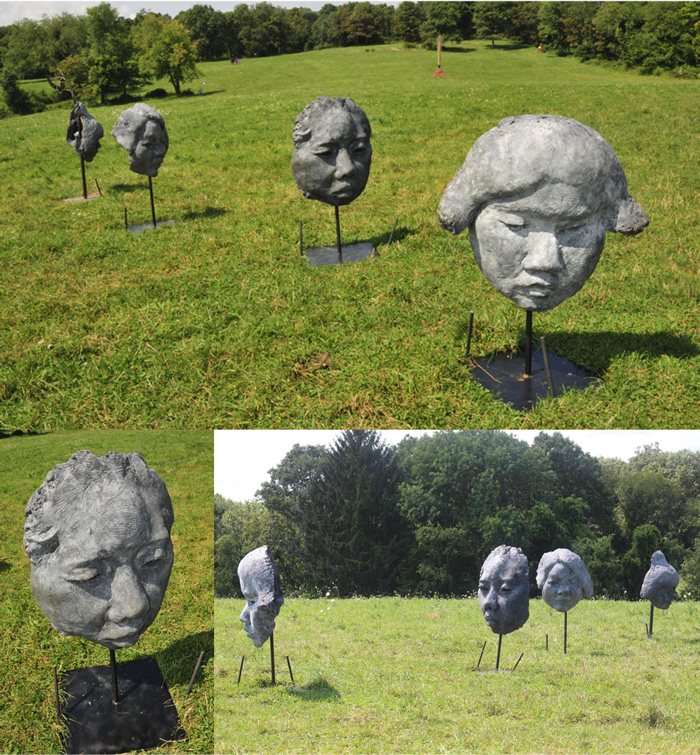
Asian Portraits (Copy)
Barney Hodes
black concrete
My work keeps shifting its balance between the person I am working from, and a sense of what sculpture is that has come down to this moment. I choose the models for reasons that are private. Because of their scale, their material, and the way they are modeled, the sculptures that result are public.
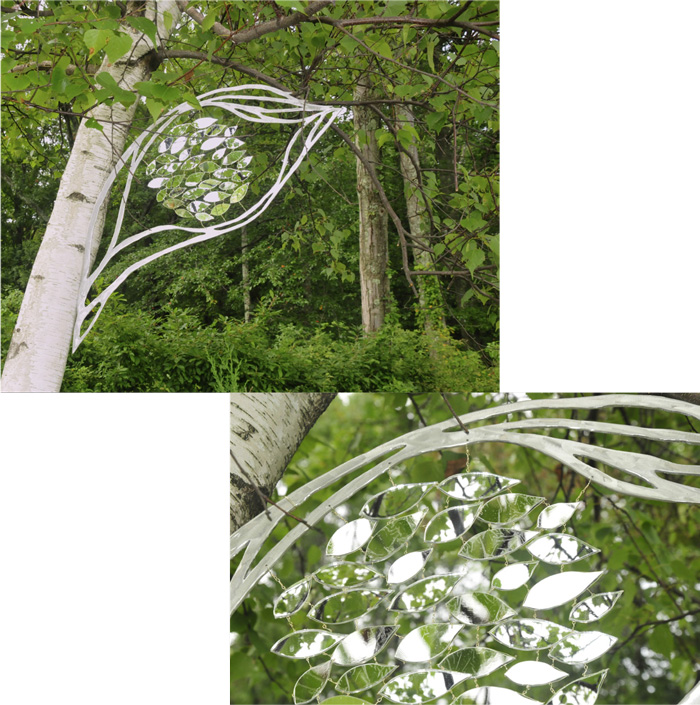
Forest Moon (Copy)
Cathrin Hoskinson
mirrored plexiglas, aluminum
Here is a place where the light of the moon shines through the trees, and illuminates one area as it does on the ocean. The branches catch and hold the shimmering ball of silver-filled leaves.
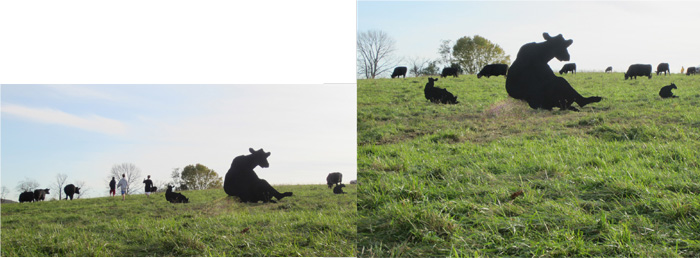
Ciao Chow (Copy)
Anne Huibregtse
mixed media
Three views of Ciao Chow, one of Sandy Saunder’s cows who died two years ago.
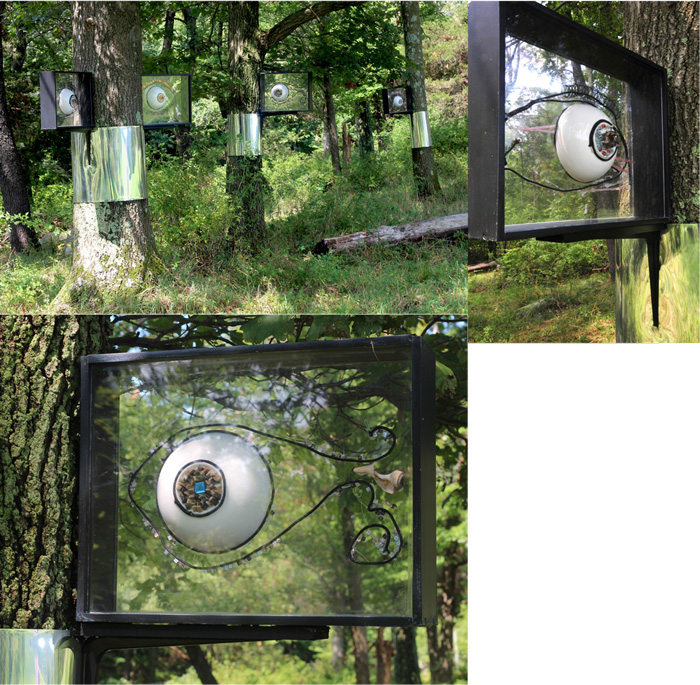
Eyes (Copy)
Elena Kalman
wood and plexiglass boxes with multi-media collage inside
We are all used by now to the diminishing expectations of privacy.
So, it may not be a surprise to find that while you are looking at art, the art is looking back at you.
My new installation created for the Collaborative Concepts 2013 Farm Project consists of five transparent boxes with three-dimensional assemblages representing eyeballs in them mounted on the trees. If you did not expect the trees to watch you - think again!
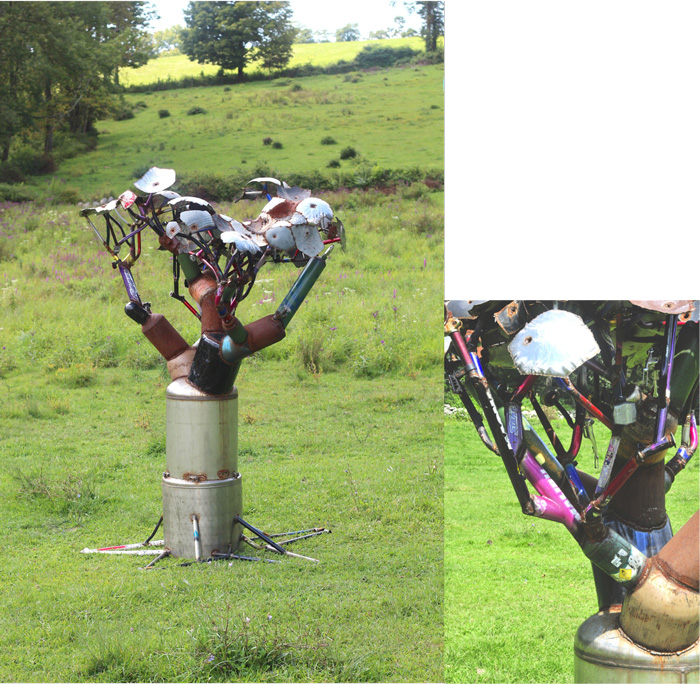
One into Many into One (Copy)
Bernard Klevickas
upcycled abandoned bicycles, oxygen, argon and nitrogen tanks,
steel bucket and other containers
From gathering the free materials in an urban environment: broken
nitrogen tanks, de-commissioned welding tanks, abandoned bicycle frames, a steel bucket with a hole in it, and found sheet steel and stainless steel, a structure mimicking nature develops. One structure sprouts another, sprouting another, and branches separate into multiple branches, which all terminate with a surface that spreads, and connects.
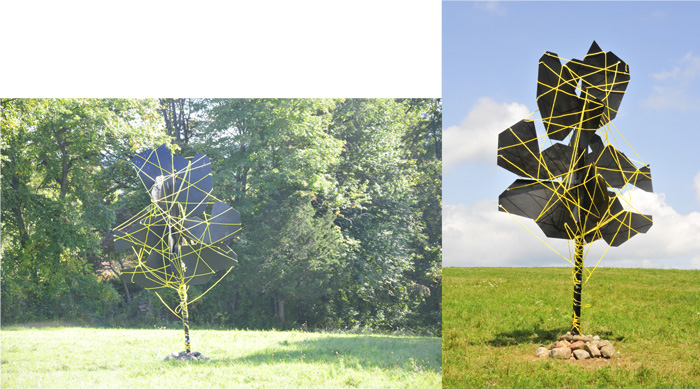
Untitled (Copy)
Kevin Laverty
painted wood, nylon twine, washers
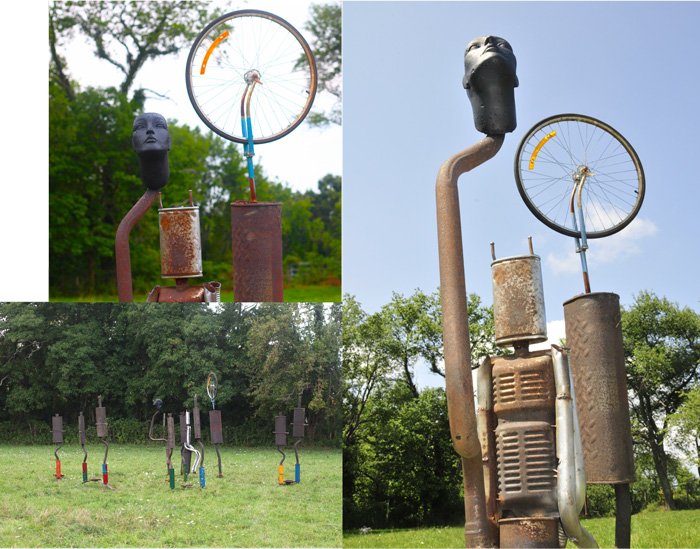
Cabaret Voltaire (Copy)
Jim Lloyd
welded scrap steel, bicycle wheel, and plastic head
Like many young artists, Ferrosynthesis was a Dada, but unlike most, he never outgrew it. Therefore self-assembly found itself in the form of Marcel Duchamp hosting and and Francis Picabia entertaining the seated multitude.
The cows have come to visit and they have been warmly received.
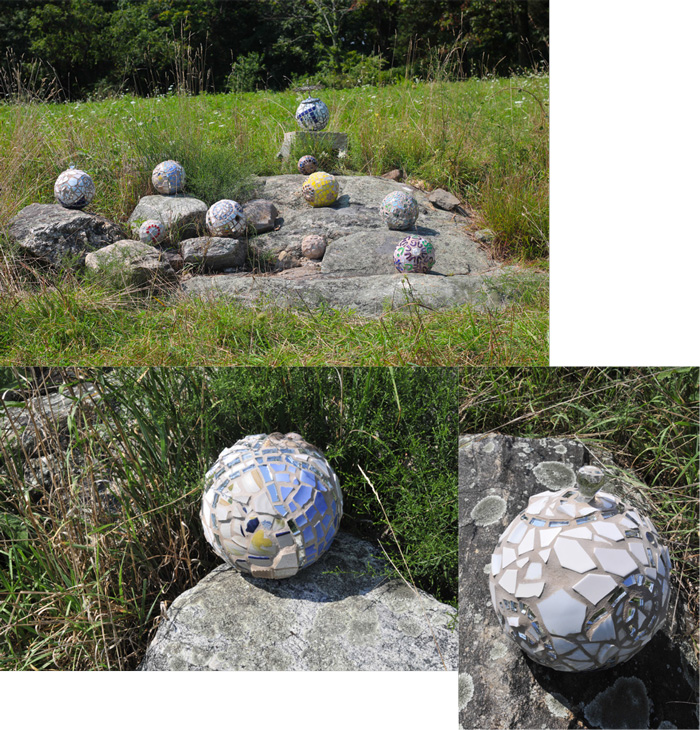
Bowling with Hendrick Hudson’s Half-Moon Crew (Copy)
Brook Maher
found materials
“...It was a fact, handed down from his ancestor the historian, that the Catskill Mountains had always been haunted by strange beings. That it was affirmed that the great Hendrick Hudson, the first discoverer of the river and country, kept a kind of vigil there every twenty years, with his crew of the Half-Moon, being permitted in this way to revisit the scenes of his enterprise, and keep a guardian eye upon the river, and the great city called by his name. That his father had once seen them in their old Dutch dresses playing at ninepins in a hollow of the mountain; and that he himself had heard, one summer afternoon, the sound of their balls, like long peals of thunder.” from RIP VAN WINKLE, A Posthumous Writing of Diedrich Knickerbocker by Washington Irving
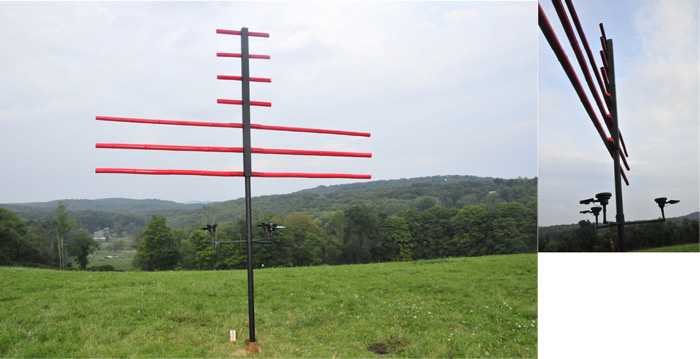
Red on White and Blue #3 - Divided (Copy)
John Martin
painted bamboo, steel, solar lights, wood
“Red on White and Blue #3 - “Divided” is the third in a series of seven red bamboo poles meant to evoke the flag. The piece is displayed about seven feet off the ground to allow for the white and blue to be provided by the sky.
Bamboo, the color red, and the number seven carry a lot of emotional symbolism, which is an important part of this series. This piece is meant to be symbolic of the current division in our country. The length and separation of the “red stripes” is true to the flag, with the exception that the open blue field in which the fifty states stars would appear is on both the left and right - ergo, the country divided.
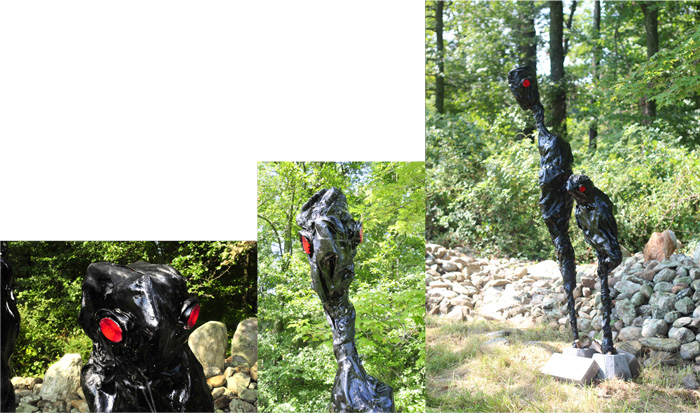
Big Spook Little Spook (Copy)
Lynne Mayocole
mixed media
Walking through the woods, in a small clearing, there they are
-- SPOOKS! Their red eyes stare at you -- are they moving? LOOK OUT!
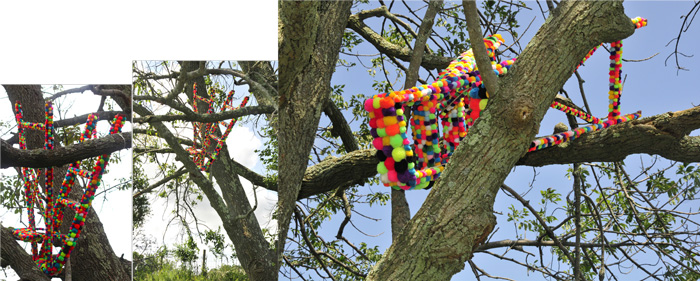
POM! POM! Extravaganza (Copy)
Maureen McCourt
ladder, pom-poms, glue
The act of covering tools with craft pom-poms takes the object’s function away, yet draws attention to the object. I am discussing issues about gender and labor, the value of labor. I am transforming a hard object into a soft object; this change creates a new playful way of interacting with the object. I make this object to provide a humorous way of discussing societal notions of gender and labor. The vibrant color of the object against the beauty of the farm will engage people.
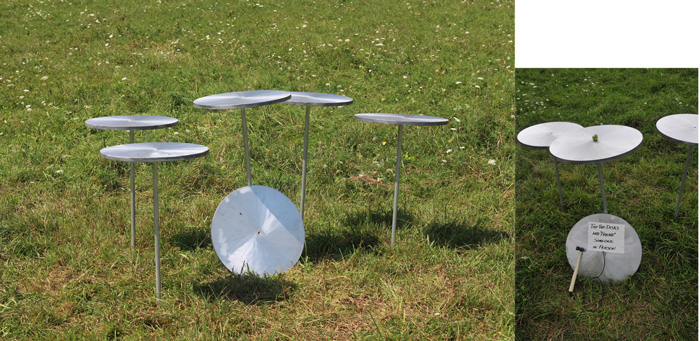
Social Network (Copy)
Mick McGuire
aluminum, steel
It is almost impossible to ignore the reach of electronic social networks that spring, mushroom-like, all around us and creep into our lives–even here on Saunders Farm. This piece is a physical manifestation of these networks in a more tranquil environment.
Strike the disk to “Friend” someone.
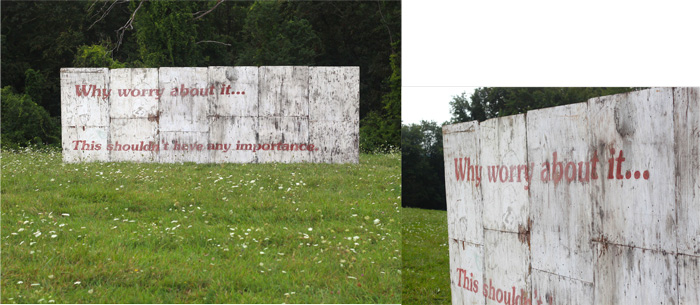
The Integrity of Caring (Copy)
James Mulvaney
painted plywood, wooden studs
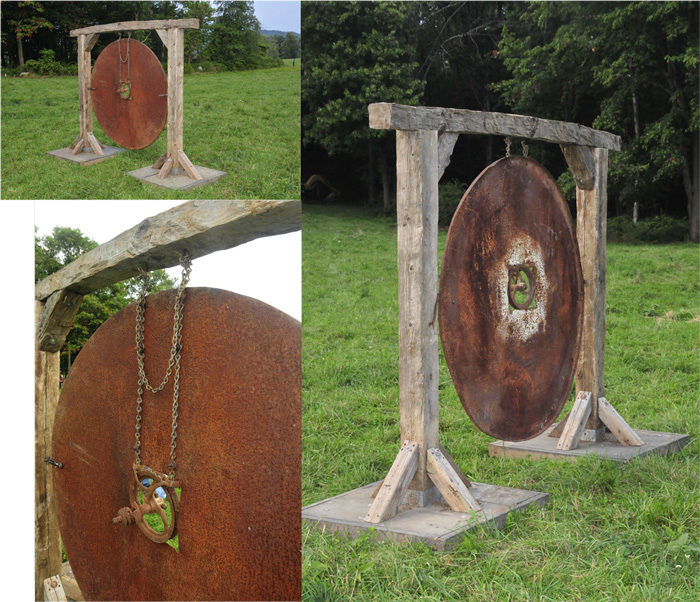
Redneck Gong (Copy)
Michael Natiello
timber and steel
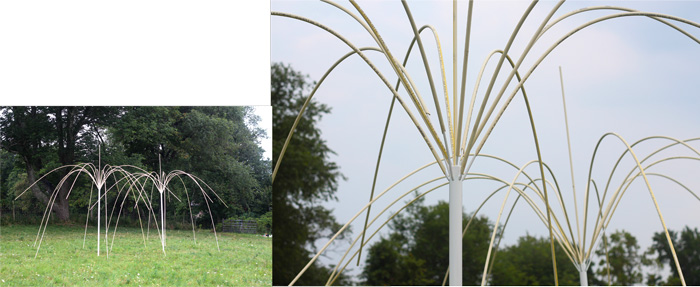
The Geometry of Light (Copy)
David Provan
powder-coated steel, PEX tubing
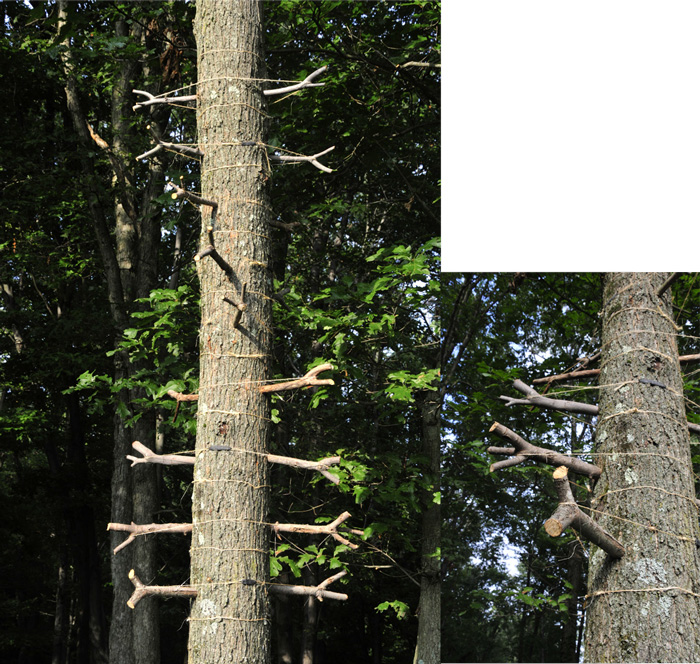
Double Arbor Helix (Copy)
Winn Rea
rubber bands from recycled bicycle tires, fallen tree branches
“Double Arbor Helix,” 2013, explores the fact that each tree has unique DNA that is surprisingly similar to human DNA.
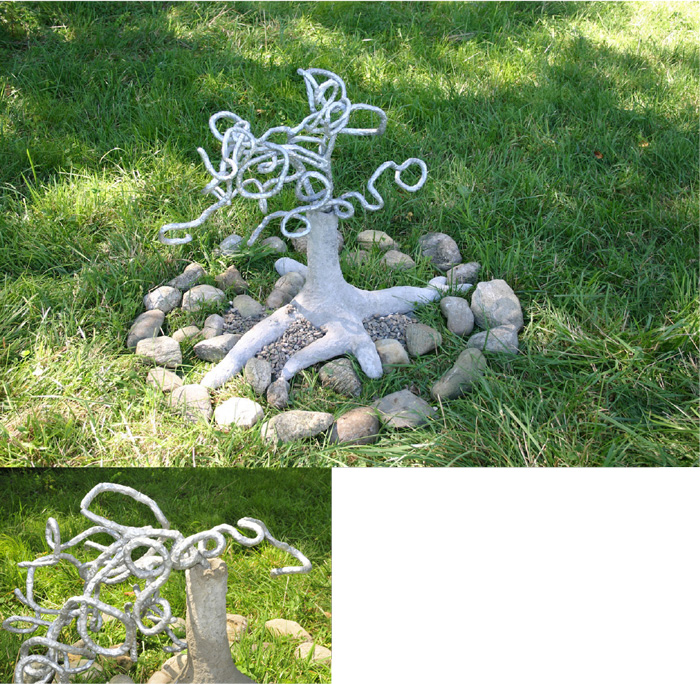
Outcrop (Copy)
Karen Roff
concrete, engineered metal, metallic finishes, mixed stones
“Outcrop” is the next generation of reconstruction, a form that is constructed of a material that, although derived from stone, is a manufactured product that has undergone transformation. Concrete, as a building material, suggests the idea of permanence; however, unlike the woven reconstructions of tree segments that have been left to weather and decay, “Outcrop” is expected to endure for decades. The upper branches are made from an engineered metal in a curvilinear shape that resembles the organic, but in a superficial way. The shiny surface is meant to capture and reflect the light, and react to specific environmental conditions, and the circle of rough fieldstones around the sculpture suggests a timeless permanence while relating the form to its site. “Outcrop” is a hybrid form that emerges from an earthen origin, a new composite construction not unlike the high-tech products that are being marketed, which begin to approximate life.

Pink Elephant (Copy)
Herman Roggeman
steel
Back in 2000 I started working on the Alexander Calder Airplane Project with George Gordon. I created a small pink elephant for a stabile incorporating Calder’s elements. I thought it would be a good sculpture to enlarge for the farm show and this time use my own elements.
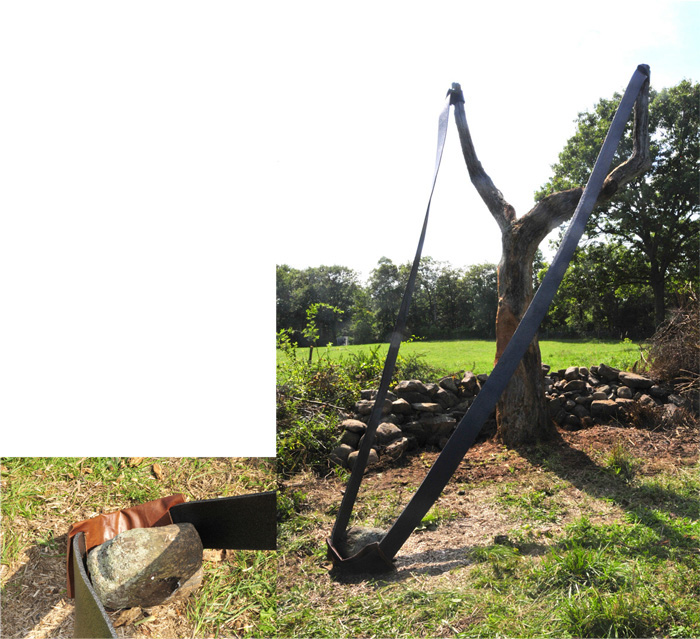
Weapon of Mass Destruction, ca. 2063 (Copy)
Mario Rusich
dead tree, rubber band, stone
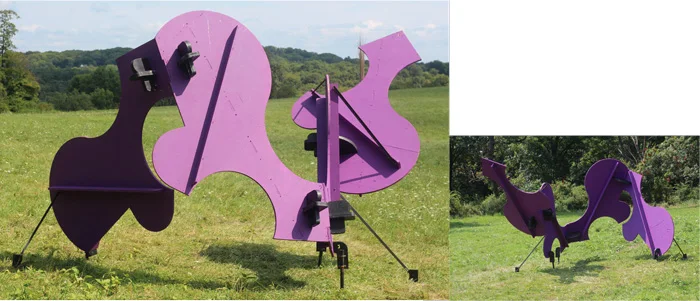
Dienos Sauros (Copy)
Peter Schlemowitz
reinforced plywood
An exploration of the paradigm, endless sculpture created from connected modular pieces that contrast positive against negative shapes, producing an image perhaps.resembling a creature.
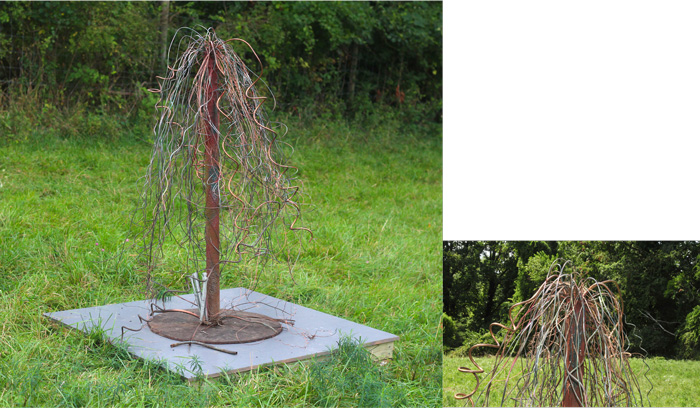
Mary’s Hair in the Morning (Copy)
Fred Schlitzer
copper, enamel paints, steel
In this piece, I wanted to capture the natural curly hair my wife has when she wakes up in the morning. She then spends a great deal of time straightening her hair each morning, much to my displeasure. She wants straight hair and I love her Mary curls.
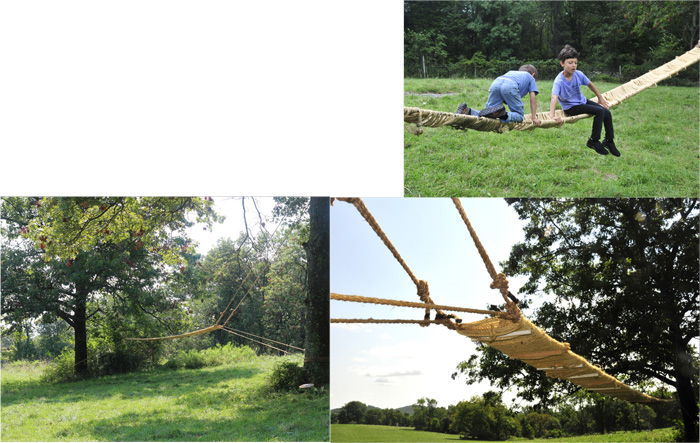
Rest (Copy)
Kevin Stapp
manilla rope, sisal rope, sisal twine
It’s a rest stop
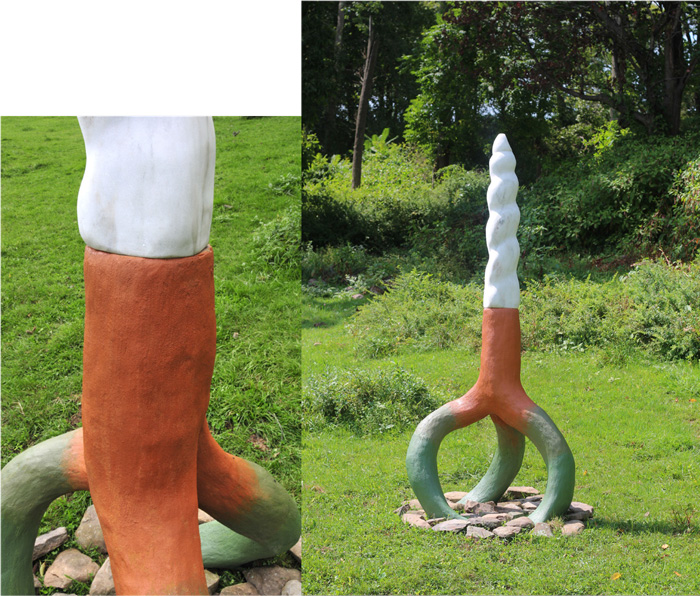
Terra Stele (Copy)
Naomi Teppich
ferro cement, Vermont marble, cement enamel
“Terra Stele” is a growing force stemming from the earth – an undulating form turning into a white pinnacle. The various plants that grow in the spring and other seasons that change dramatically in form and color from one day to the next influenced me. The piece is also a testament to living things and preservation of our earth.
I built this piece in 2006 for the outdoor sculpture show in Dumbo, Brooklyn, at the Empire Fulton Ferry State Park, which is along the East River between the Brooklyn and Manhattan Bridges. Later that year, it was exhibited at the High School campus in Summit, NJ. “Terra Stele” was also shown at Sculpturefest in Woodstock, Vt., in 2008.
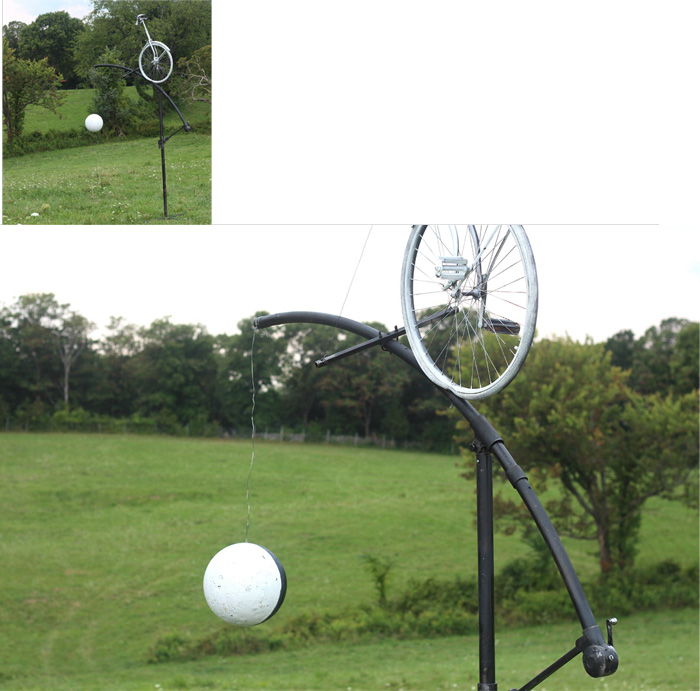
Over the moon (Copy)
Jim Thomson
recycled and reclaimed objects
It is an illustration from the poem.
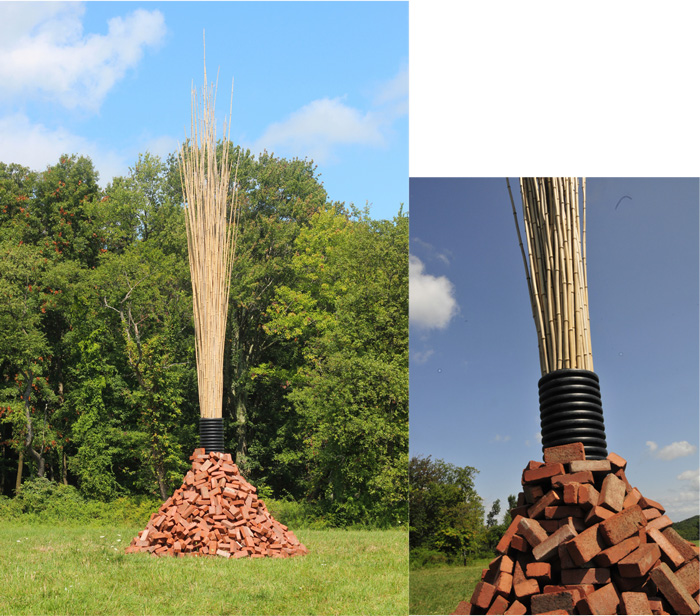
Eruption (Copy)
Alex Uribe
brick, PVC, bamboo
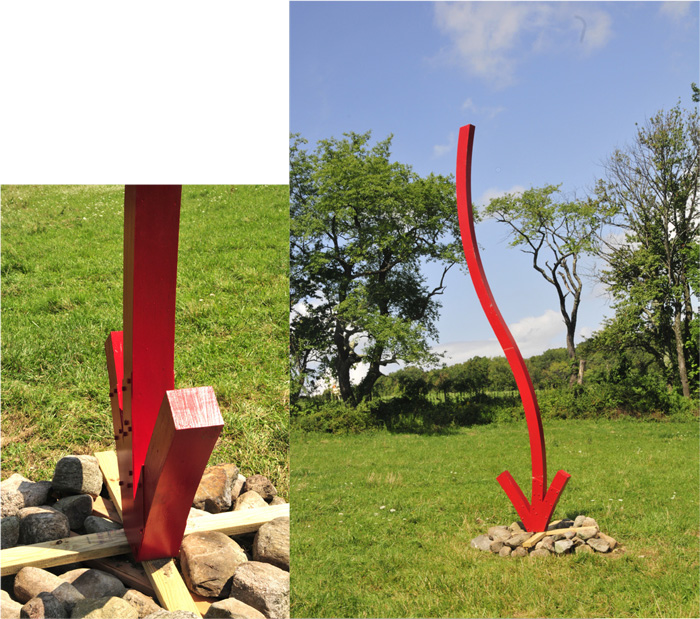
Nomme de Terre (Copy)
Chuck von Schmidt
wood and a little steel
“Nomme de Terre” is a Duchampian gesture. By signing (vS) the landscape, I have made it my work of art.
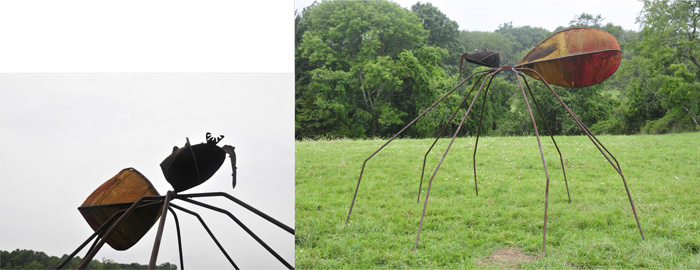
Bella (Copy)
Robert Van Winkle
steel, cast foam
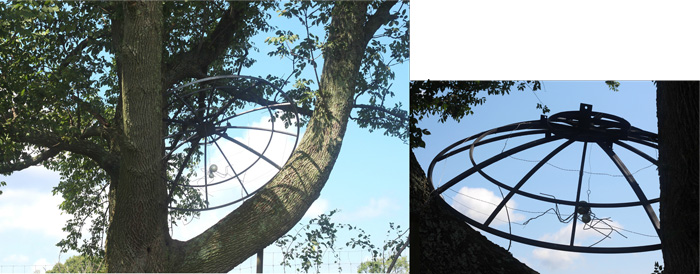
Resonance (Copy)
Eva Whorley
TV satellite dish and frame, stainless steel wire
“Resonance” is 7 feet in diameter. It is made from an old satellite dish. I have added reclaimed stainless steel wire to enhance the web and create the spider. It is a play on how nature hears and how man hears through resonance and vibration.
Nature is calling out to mankind to cease and desist the destruction to the environment.
Perhaps with the use of the satellite dish the message will get through
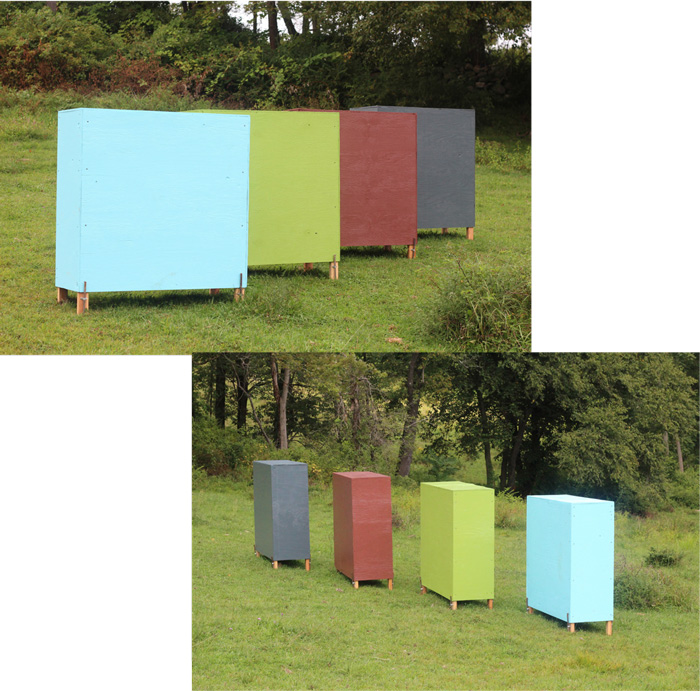
Sky, Grass, Earth, Stone (Copy)
Ellen Wilkinson
plywood
The forms are related to Post-its serving as markers or labels marking the land. The colors come from the natural elements of beautiful Saunders Farm. So each of the four colored markers isolates a distinct part of the natural site. My objective is to intensify awareness of the site by creating a sculptural object which refers to the site itself.
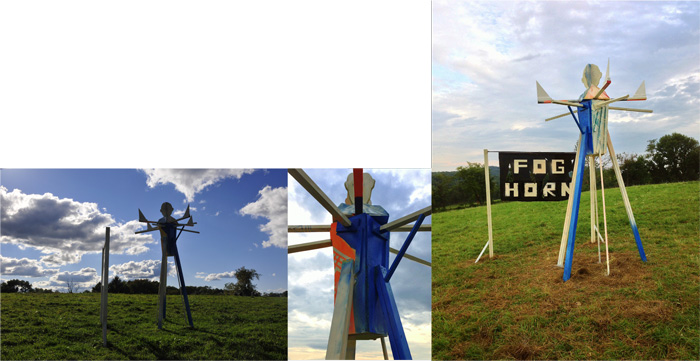
Fog Horn / Stickman (Copy)
Max Yawney
mixed media paints on wood and plastic
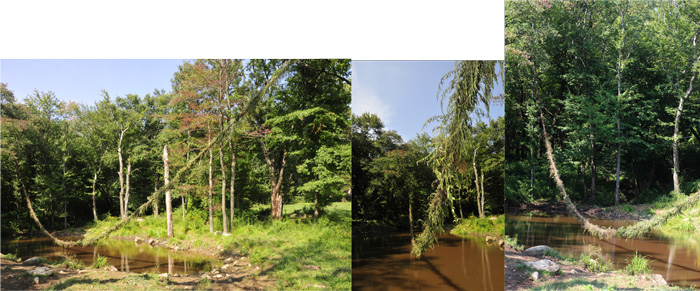
SKYBOW (Copy)
Roy Staab
mugwart, goldenrod, reeds, weeds, jute, and bailing twine
ecoartspace commisioned installation
“Skybow,” 2013 was created by Roy Staab over a period of ten days beginning on August 20th. Based in Wisconsin, Staab has traveled the globe for 30 years to make his elegant works in natural settings, which are first and foremost created in response to the specific sites. He had the difficult task of choosing his location just weeks ahead for Saunders Farm without the usual time he needs to survey the landscape. He chose the pond, as he prefers to work in the water for its movement and reflective surface as a backdrop. The pond at Saunders is also a favored spot for a herd of Black Angus cows that roam freely; the edge was trampled and the vegetation was far from pristine. The water had an unpleasant odor, was brownish-green and not at all transparent, but Staab was determined to use this location. He thrives on a challenge and wanted to traverse the entire span of the pond with a suspended work.
Staab decided to make a 300-foot-long arc to cross the horizontal length of the pond creating a perfect line drawing in space. The position of this catenary line was determined by tall trees at either end. Suspended between the trees, the line moves gracefully as wind blows in the treetops, while the surroundings stay stationary.
Staab’s works always make use of accessible organic materials found on site. In this area it was wild weeds–mugwort, goldenrod and reeds, which he tied together with jute using an armature of sessile bailing twine. He then painstakingly laid out the material to create the line, working quickly with precision and taking good weather and sunlight to his advantage. Being inventive, Staab borrowed a bow and arrow and shot the twine across the pond in order to suspend it between the trees. This attempt failed. He then tried the more difficult task of throwing a weighted rock, which took many tries but succeeded. On the opposite side of the pond he climbed a 40-foot-tall tree to attach the line, but the weight of the length was the next engineering problem to tackle. The suspended weeds dry out and shrink
and the knots he makes in the jute made it tighter, but the line stretched out, which caused it to sag. Eventually he achieved his desired length and height of the line to create a visual tension centered in the middle of the pond–away from the appetite of the cows.
A few days after the work was completed the curved line was hovering at its lowest point, nearly touching the water after the rain. It swayed and danced in the wind just above the surface. This is the effect Staab most desires when Nature contributes to the beauty of his art. His works are in and of their environment, as opposed to being about site or space. They are not placed into a new context from where they are made, but created in the setting, inseparable from it and only subtly distinctive. Once accomplished, “Skybow” was studied from all angles and in the changing light during different times of the day. Staab then set up his camera and tried to capture all of this in a perfect shot.
Staab intends for his ephemeral artworks to decompose slowly as in all of nature. The continual changes of weather, wind, and the toll of time will eventually cause their demise. The fresh green materials begin to wilt and turn dry and brown, showing the process of life and death and the cycle of all living things. Amy Lipton Curator. ecoartspace
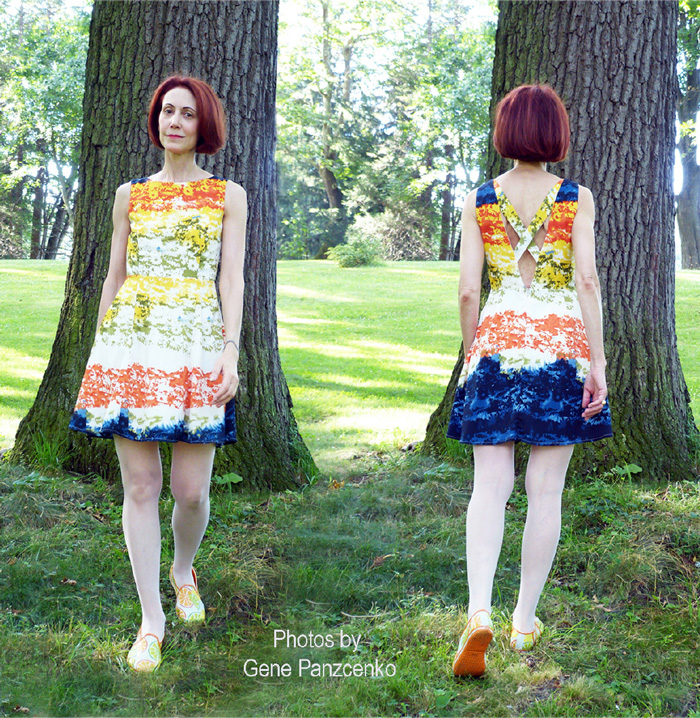
From Tree to Tree and Back Again (Copy)
Marcy B. Freedman
Marcy B. Freedman brings to Saunders Farm an example of her one-on-one, face-to-face interactive performance art style. “From Tree to Tree and Back Again” engages members of the public in an experience of both silent and verbal communication. Each participant is invited to walk with the artist from one certain tree to another tree, without talking. Then, while walking back to the original tree, the artist invites the participant to tell her what thoughts, if any, passed through his or her mind during their shared walk in silence. When appropriate, the artist will share her own thoughts.